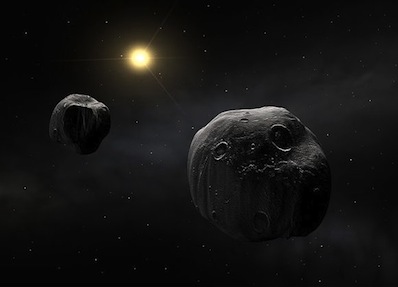


|

|
 |
|
Asteroid split caused by dizzying spin rate AMANDA DOYLE ASTRONOMY NOW Posted: 28 March 2012 Asteroids that travel through the Solar System close to a companion but not as a bound binary pair could still have shared a common origin, perhaps even spinning apart from one single object, report astronomers at the National Astronomy Meeting in Manchester this week. Asteroids spin as they travel along their orbits, and this rotation rate can be changed by the Yarkovsky–O'Keefe–Radzievskii–Paddack (YORP) effect. The YORP effect occurs when radiation emitted by small bodies also carries away momentum. If the YORP effect causes changes that go beyond the spin limit of the asteroid, then it can cause the asteroid to change shape. It can also result in a single asteroid being pulled apart to become a binary asteroid (read our earlier story Fast spinning asteroids spawn new generation here)  An artist’s impression of a double asteroid. Image: ESO If one member of an asteroid binary is significantly smaller than the other, and this secondary comes close enough to the larger for gravitational interactions to occur, then it is possible for that the secondary asteroid will break free. The two asteroids then continue on their journey around the Sun in similar, but separate, orbits. Simulations of the orbits of unbound asteroid pairs show that many of them would have had close encounters with each other less than a million years ago. However, this is still not sufficient evidence to prove that they originated from one asteroid. In order to confirm a common origin, then the composition of the two asteroids needs to be measured, and this can be done using spectroscopy. Samuel Duddy from the University of Kent, along with his colleagues, made spectroscopic observations of several of these unbound asteroid pairs using the 4.2 metre William Herschel telescope and the 3.6 metre New Technology Telescope. Duddy detailed the results of these observations at the National Astronomy Meeting this week where he revealed that the asteroid duo (7343) Ockeghem and (154634) 2003 XX38 have very similar compositions, which strongly suggests that they have a common origin. In addition, both asteroids are of the same taxonomic type. While there were other convincing examples, not all of the binary pairs had matching compositions, which indicates that there must be more than one method of formation for asteroid pairs. |
|
|
|
|